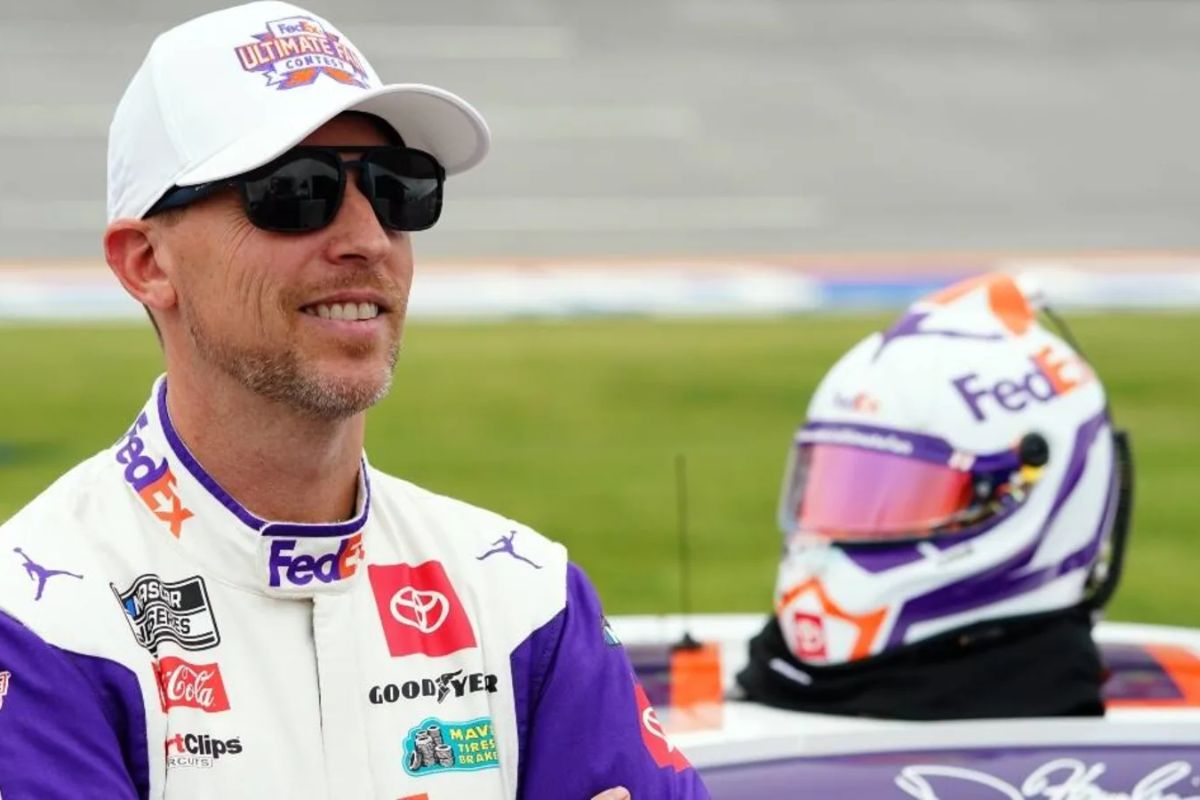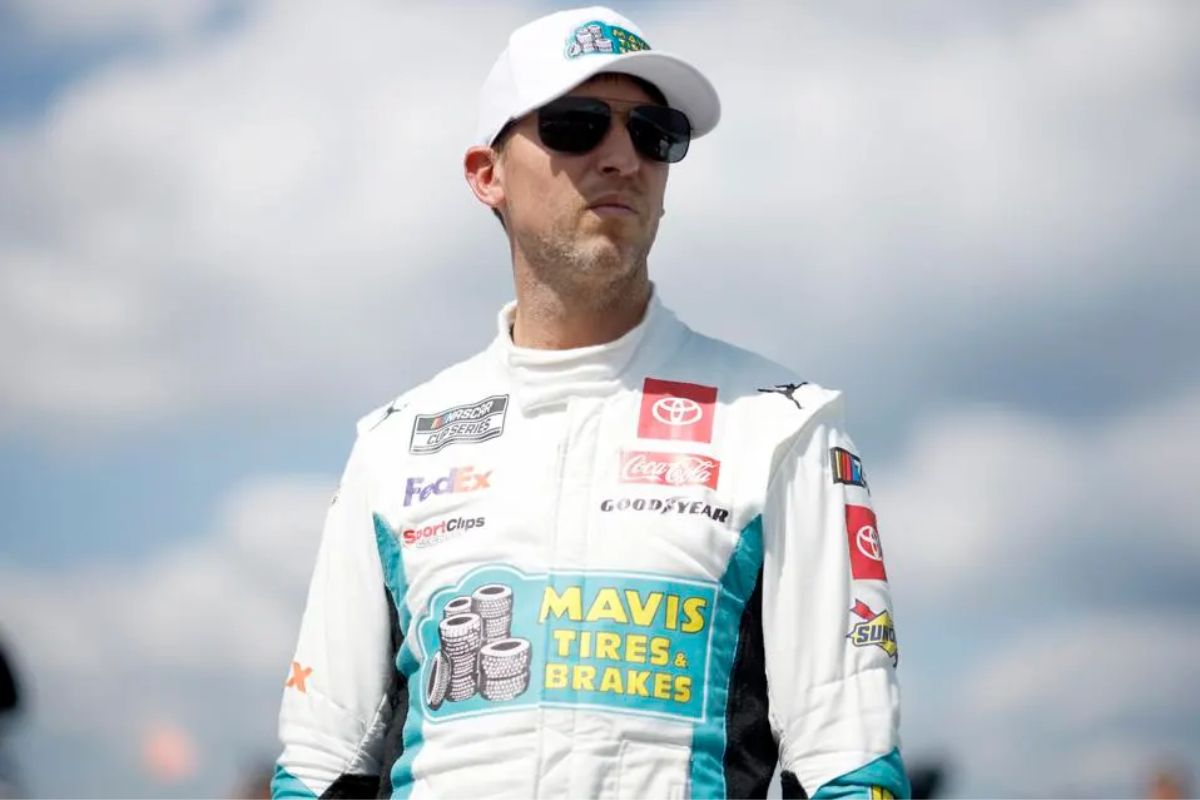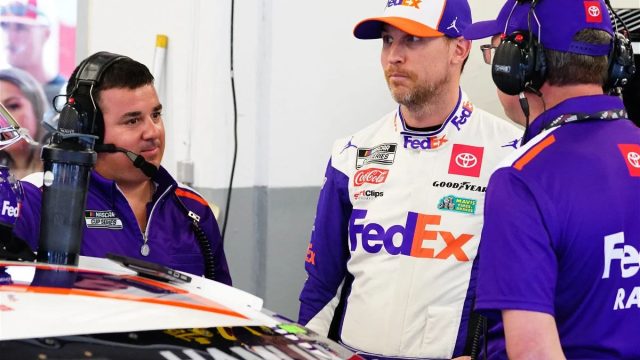Denny Hamlin Blames Larson: Denny Hamlin‘s recent remarks emphasizing the responsibility on Kyle Larson for the incident that fueled Kyle Busch‘s frustration have sparked significant debate within the NASCAR community. Hamlin points to Larson’s demanding double-duty schedule as a contributing factor to the on-track mishap, suggesting that fatigue and stress may have impaired Larson’s decision-making. This perspective not only highlights the intricate dynamics of driver interactions but also emphasizes the emotional and physical toll of competing at such a high level.
Key Highlights
- Denny Hamlin attributes Kyle Busch’s frustration to Kyle Larson’s actions during the final lap of Stage 2.
- Larson’s move led directly to Busch’s crash, intensifying Busch’s emotional turmoil.
- Busch’s challenging season is compounded by incidents like the one with Larson, impacting his performance.
- Hamlin believes Larson’s busy schedule affects his decision-making, leading to incidents like the crash with Busch.
- Hamlin highlights the emotional strain on Busch, transitioning from dominance to current struggles, aggravated by on-track clashes.
Incident between Kyle Larson and Kyle Busch
In the final lap of Stage 2 at Sunday’s NASCAR Cup Series race at World Wide Technology Raceway, Kyle Larson and Kyle Busch’s top-10 cruise was disrupted by a series of bumps that left both drivers with differing perspectives on the incident. As the two past champions battled for position, their clash became a focal point of the race, sparking varied reactions from each driver.
Kyle Busch, evidently displeased with the outcome, questioned the necessity of Larson’s action. “Not sure what that single point was really gonna mean for him, but certainly hurt us a lot,” Busch remarked, indicating that the impact of the move was more detrimental than advantageous. His frustration was noticeable, highlighting the competitive nature of NASCAR where every point can influence standings and future strategies.
Conversely, Kyle Larson adopted a more composed stance regarding the encounter. Larson explained, “Left (Turn) 4 to side-draft him and barely touched his quarter panel. I don’t know. I’m guessing it ticked him off.” Larson’s perspective suggested that the contact was incidental and not intended to provoke or harm Busch’s race performance. This difference in interpretations showcases the subjective nature of racing incidents, where intent and impact can be perceived differently by those involved.

Denny Hamlin’s Perspective on the Incident
Denny Hamlin entered the conversation by attributing the fault to Kyle Larson, suggesting that Larson’s double-duty schedule might be contributing to his on-track decisions and accidentally triggering Kyle Busch’s frustration. Hamlin’s perspective sheds light on the intricacies of managing dual commitments in racing, where balancing multiple series can lead to heightened stress and potential lapses in judgment.
Hamlin indicated that Larson’s intense schedule might be causing lapses in his on-track decisions, pointing to the possibility that the stress of fulfilling obligations in different racing series is taking a toll. This perspective adds complexity to the incident, suggesting that external factors beyond the immediate race might be influencing driver behavior.
Analysis of the Crash and Hamlin’s Comments
Amidst the chaos of the crash, Kyle Larson’s move heading into Turn 1 sparked a chain reaction that ultimately ended Kyle Busch’s promising race. As Larson’s No. 5 car slid sideways, it made contact with Busch, sending the latter into the outside SAFER barrier in Turn 2. Busch had been leading for 15 laps, marking his initial time at the front since Kansas on May 5. This incident, given Busch’s recent struggles to maintain leads, understandably left him frustrated.
Denny Hamlin, a seasoned driver, offered his perspective on the crash during his podcast. Hamlin described the sequence of events leading up to the collision:
“While this is all an opinion, I think that it’s pretty accurate that… he [Kyle Larson] pissed Kyle [Busch]off by running into him straight away. Kyle then turned left, while the #5 was beside him and wanted to show them. ‘Hey dude, like don’t. That’s bullsh*t. And then… They both crashed into the next corner. I mean that that was it. Bush’s day was over and Larson ended up 10. Bush got into the bad end of that deal.”
Hamlin’s comments highlight the high-stakes NASCAR racing, where split-second decisions can have significant repercussions. His insight suggests that Larson’s aggressive actions incited Busch’s retaliatory responses, exacerbating the situation.
While Larson managed to finish 10th, Busch’s race was abruptly terminated, leaving him on the losing end of the incident. Hamlin’s analysis provides a compelling narrative that frames Larson’s actions as the catalyst for the crash, emphasizing the intricate dynamics at play on the racetrack.

Further Analysis of the Incident
Examining the intricacies of the crash further, it becomes evident that the series of contacts between Larson and Busch were decisive in the outcome of the race. The initial contact was initiated by Larson (No. 5), setting off a chain of events that led to both drivers spinning out. Larson’s aggressive entry into the corner, rather than backing off to avoid further contact, was a critical decision. According to Denny Hamlin’s analysis, Larson could have mitigated the risk by adjusting his approach after the initial contact, ensuring he did not slide into Busch (No. 8) again.
“Okay, I’m just gonna back up my entry here, make sure I don’t slide into #8 again after that initial move.” – (hamlin)
“Bush had the most to lose and did lose the most. He didn’t want to get run into anymore.” – (hamlin)
However, the subsequent dynamics between the two cars were equally significant. The #8 car, driven by Busch, appeared to leave adequate room on the track. Yet, the tight positioning of Larson’s car caused it to get loose, resulting in further contact with the left rear of Busch’s car. This additional contact destabilized both vehicles, leading to a fourth and final tap that resulted in their simultaneous spin-out.
Critically, Busch had the most to lose in this scenario, a sentiment echoed by Hamlin. The compounded contacts not only threatened Busch’s position but ultimately resulted in a significant loss. The frustration stemming from these interactions, which Hamlin attributes to Larson’s actions, emphasizes the complexities of racecraft and the thin margin for error.
Denny Hamlin’s Analysis of Kyle Busch’s Emotional State
In the All-Star race, Kyle Busch had a problem with Ricky Stenhouse Jr. It started when Stenhouse bumped into Busch. Then, Busch hit Stenhouse’s car door on the second lap, ending Stenhouse’s race. This led to a physical fight between them. Denny Hamlin noted that Busch is trying to race cleanly and avoid accidents, but other drivers are taking advantage of his effort to stay clean.
Kyle Busch’s current emotional state, as analyzed by Hamlin, reflects the significant change and frustration that comes with evolving from a dominant force in NASCAR to facing a challenging season. Busch, with an illustrious career featuring 63 wins in the Cup series, is undeniably one of the sport’s greatest. Yet, this season has not aligned with his historical performance, leading to tangible frustration.
Denny Hamlin, a seasoned competitor and close observer, provides valuable insights into Busch’s mindset. Hamlin elucidates, “It’s just an emotion of- He’s spent the greater part of you know, 15. 16 years, just… Be in the man and dominating, you know. […] He’s one of the best that our sport has ever seen and now he’s in a situation where it’s like he’s not upfront every week anymore.” This statement captures the essence of Busch’s emotional turmoil: the stark contrast between past dominance and current struggles.
“They’re battling. […] And Kyle is probably frustrated that I don’t have time to work on getting better at. I’m as good as I need to be and… I’m driving the cars as fast as they’ll go, but they’re not going.” – (hamlin)
Such a shift is not simply a statistical anomaly but a profound psychological adjustment for an athlete of Busch’s caliber. The expectation to consistently perform at the top tier, ingrained over years of success, creates an internal challenge that intensifies when those expectations are unmet. Hamlin’s analysis highlights the human element behind the racing helmet—a driver grappling with evolving dynamics within the sport.
Understanding Busch’s frustration through Hamlin’s perspective offers a detailed view of the challenges faced by elite athletes. It emphasizes the resilience required to navigate the highs and lows of a competitive career.

News in Brief: Denny Hamlin Blames Larson
Denny Hamlin’s emphasis on fault to Kyle Larson for the incident involving Kyle Busch highlights the intricate dynamics of NASCAR racing, where off-track commitments can influence on-track performance.
Hamlin’s perspective highlights the demands and emotional challenges faced by drivers like Busch, who is expected to consistently deliver top-tier results. This incident serves as an example of how external factors and split-second decisions profoundly impact both the competitive environment and individual driver emotions.
Our Reader’s Queries
Q: How many wins does Kyle Busch have?
A: Busch holds the record for the most all-time NASCAR national series wins with 229 victories (63 NASCAR Cup Series wins, 102 NASCAR Xfinity Series wins, and 64 NASCAR Truck Series wins). He currently maintains a 10-season streak (2013-2022) of posting wins in all three NASCAR national series.
Also Read: Denny Hamlin’s Historic Streak Terminated
